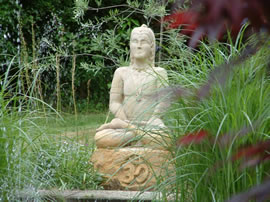Mantras and Chants – Premanand Giri
This article was written by Mahant Premanandaji Giri, who is a regular visitor to the ashram. At satsangs, he regularly entertains us with chants and songs and his excellent guitar playing.
All matter originates from vibration, and the audible aspect or quality of that vibration is sound, which can also be felt internally as sympathetic vibration. “In the beginning was the Word, the Logos, and the Word was God, and the Word was made flesh.” At causal, creative level, this Word or sphota is said to be beyond the scope of the normal range of our auditory and mental equipment, but becomes manifest as Nada Brahma, divine sound, that which can be heard by yogis and rishis within. Eventually this manifests on a gross or earthly level as shabda and varna, words and letters, by means of human intelligence and the mystery of the Goddess of speech, Vak, or Ma Saraswati Devi.
The letters of the Sanskrit alphabet, from which English, amongst other Indo-European languages has developed, represent seed sounds, ”bija mantra”. In themselves they often have no specific meaning but carry great psychic power. The repetition of these sounds, with devotion and awareness of meaning, ”will introduce a new rhythm and harmony into the personality, which calms the nerves and unifies the powers of the mind…in due course, this leads to an awakening of the spirit within”. (Swami Yatiswarananda)
Thus mantra is holy sound. Mantra literally means “mind-freeing,” that is, release from the clutches of the all pervasive ego. Release brings relief and joy. By concentrating on the sound, with a feeling of atma bhava or siddh bhava, (attitudes of loving devotion and intelligent, meaningful power) the practitioner seeks to free his/her mind from the mundane cycle of everyday events (samsara) to find peace and harmony within, to a wider sense of reality and super, or supra consciousness.
Mantras may be chanted aloud, muttered under the breath or repeated silently. The gross sublimes to the subtle, so the last is said to have the greatest power. Uttering the mantra releases some of that power, which is why some are kept secret; however chanting, especially communally, can be a great source of joy and spiritual release.
It is said that a mantra should be delivered by a Guru, a realised spiritual being. This is true, partly because of the power of siddhis accruing therefrom which may be easily abused, and because the Guru should be able to see into the mind of the disciple and select a mantra suitable for him/her. There are many mantras in the public domain which may be used and chanted by people from all walks of life with beneficial healing and life-enhancing effects; but to activate the shakti or spiritual driving force of the mantra, initiation (diksha) through a guru is essential. The Lord manifests in the heart of the Guru and transmits spiritual power to the heart of the disciple. This is Guru Parampara. As the mantra emanates from the soul of all being that energy is reflected in one’s own soul, and hence one’s life, as the moon reflects the light of the sun.
The origin of all audible sound is Aum; all sounds are contained within it. Aum forms the root basis for all creation; it precedes mantras, ends mantras, and is a universal mantra. Aum is a symbol, visual and aural, of infinite power, and is a means for release (moksha). In the Bhagavad Gita, Sri Krishna says the syllable Aum, uttered at the time of death, will bring one on to Him, (B.G. 8:13); indeed He says He is the pranava, “that which should be worshipped”, “pavitram omkara”. It is a means for release from samsara and the round of births and deaths:
“We offer obeisance and praises to the sound symbol Om, of the same nature as the sacred creative seed. Always the subject of meditation by yogis, Aum brings fulfilment of desires and release from bondage”
Patanjali Maharishi Ji says (1:27) “Tasya vacakah pranavah”, His (God’s, Ishvara’s) word (vak) is Aum. (1:28) “Tajjapah tadartha bhavanam”, It is to be repeated with meaning and feeling. Here is the key to success on the spiritual path, the raft to cross to the other shore, the power to free the mind. “Then mastery over the inner self is acquired by the removal of obstacles” (1:29)
Aum is the very embodiment of the trinity of Brahma, Vishnu and Mahesh (Shiva), Father, Son and Holy Spirit, which creates, pervades, and destroys this material universe; through concentrating on and meditating on the sound one is brought closer to the spiritual energy which sustains the process.
In it’s purest form, meditation on Aum represents/leads to nirguna meditation, that without form or qualities. Sri Krishna points out in chapter 6 of the Gita the difficulties of this practice for the majority of aspirants: the mind needs something tangible to grasp onto and assist in sanyama, i.e. saguna meditation, so concentrating on an image or form of one’s ideal is recommended. The form chosen, the Ishta devata or one wished for will vary according to historical time, culture, temperament and spiritual lineage of the aspirant, but will always be accompanied by a corresponding mantra and provide an object of focus with which she/he can identify, love and serve, and indeed ultimately become one with.
So mantra yoga involves bhakti yoga, the yoga of devotion, gyan yoga and dhyan yoga, a triad of disciplines combining that special knowledge and love which leads to peace and happiness in this world and the next…it is a raft to cross the ocean of delusion, a lakshya, a fixing point or anchor to hold fast to in times of difficulty and provide support, protection and constant renewal of the feeling of one’s closeness with God. So eventually, after many lakhs of repetition, the yogi attains at-one-ment with the very essence of the mantra.
